4.04.2019
NASA's Parker Solar Probe set for second approach to 'touch' the sun Thursday

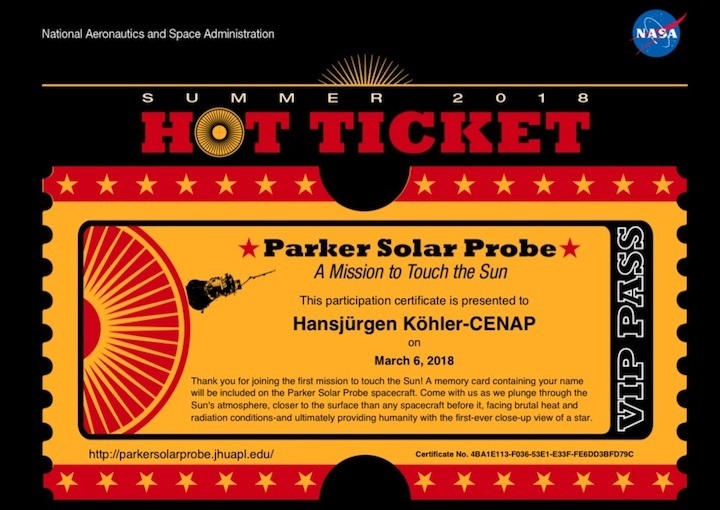
In its second journey of "touching" the sun, the NASA solar probe, roughly the size of a small car, that launched almost eight months ago from Cape Canaveral Air Force Station, will once again face the perilous dangers of our star when it reaches its second closest approach on April 4.
Named after the American solar astrophysicist Eugene Parker, who developed the theory of solar winds — the constant flow of charged particles released from the sun that spreads throughout the entire solar system — the Parker Solar Probe is NASA's ambitious mission in understanding the sun.
Launched in August 2018 from Launch Complex 37, the $1.5 billion probe blasted atop a United Launch Alliance's 233-foot Delta IV Heavy rocket and reached its first closest approach a few months later in November.
As humanity's first visit to not just the sun, but to any star, this historic mission aims to unlock the mysteries the giant ball of gas currently hosting a spot at the center of our solar system contains.
"It's going to help us be able to predict solar flares," NASA administrator Jim Bridenstine said last week at a congressional subcommittee in Washington, D.C. "It's going to help us predict coronal mass ejections potentially that could be very damaging to astronauts in deep space as we return to the moon and eventually go on to Mars. So we need to be able to predict those to protect human life into the future."
Hurtling at a speed of about 213,200 miles per hour, the zooming spacecraft will reach a perihelion (when it's closest to the sun) roughly 15 million miles away from the sun's surface at 6:40 p.m. EST on Thursday, the same distance during its first approach, NASA spokesman Geoff Brown told FLORIDA TODAY.
The spacecraft broke the record for closest approach to the sun, previously set by the Helios 2 spacecraft in 1976, which came within 27 million miles from the sun's surface, during its initial flyby back in November.
Intended to be a seven-year mission, the last three of the 24 planned orbits around the sun will have the probe flying at a speed of about 430,000 miles per hour. For comparison, it would only take one second to get from Philadelphia to Washington D.C. at that speed, according to NASA.
It will also face an overbearing temperature of 2,500 degrees Fahrenheit when it gets within 3.8 million miles of the sun's surface during those last three orbits. That's about a tenth as close as Mercury, which is about 36 million miles away from the sun on average.
After its last journey around the sun, at which point the probe will be in a stable orbit, the spacecraft will begin to disintegrate once its heat shield can no longer provide protection, Brown said.
During perihelion, which lasts until April 10, the spacecraft's four suites of science instruments will be fully operational, storing scientific data collected from within the sun's corona — the outermost part of the sun's atmosphere.
The four instruments are designed to study the sun's magnetic fields, plasma and energetic particles as well as imaging the solar wind, according to the agency.
In order to withstand the brutally hot temperature the sun will be shedding on the spacecraft, the probe is shielded by a 4.5-inch-thick carbon composite foam Thermal Protection System, keeping the spacecraft's body at a comfortable state of only 85 degrees Fahrenheit.
Once closest approach occurs, the probe will go silent for several days so it can focus on not melting, but will start transmitting data back to Earth over a period of several weeks later this spring.
In December, the probe will perform its second of seven Venus gravity assists, needed to bring the spacecraft's orbit closer to the sun.
This mission will hopefully give scientists the information needed to trace how energy and heat move throughout the sun's corona and to understand what causes solar wind and the solar energetic particles to accelerate, according to NASA.
Since completing its first orbit back in January, scientists have already downloaded over 17 gigabits of science data and will have the complete dataset fully downloaded by April.
Studying the sun will also help scientists learn more about other stars in the universe, how life developed on Earth as well as learning more about space weather, an event that occurs when disturbances in solar wind shakes Earth's magnetic field and pumps energy into radiation belts, according to NASA.
Knowing more about it and more importantly, how to predict it, will allow scientists to figure out how to protect many of the satellites humans depend on that are threatened by space weather.
"The solar wind also fills up much of the solar system, dominating the space environment far past Earth," according to NASA. "As we send spacecraft and astronauts further and further from home, we must understand this space environment just as early seafarers needed to understand the ocean."
Quelle: Florida Today
----
Update: 6.04.2019
.
Parker Solar Probe Makes Second Fiery Flyby of the Sun
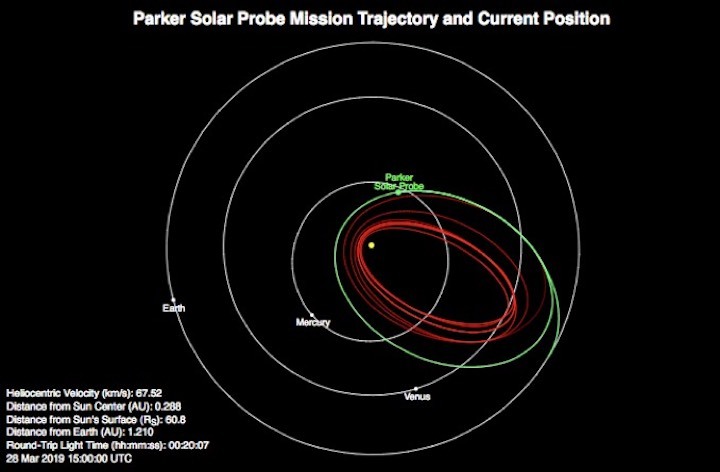
NASA’s Parker Solar Probe (PSP) made its second close approach of the Sun yesterday – the closest that any spacecraft has ever flown past any star.
PSP passed through the outermost layers of the Sun’s atmosphere, the corona, at 213,000 mph, coming within 15 million miles of the Sun itself. Closest approach, called perihelion, occurred at 6:40 p.m. EDT. PSP began this phase of the mission back on March 30, 2019, and it will last until April 10.
All four suites of scientific instruments are currently operational and will collect science data from within the Sun’s corona as the probe passes through.
Due to its close proximity however, PSP has been out of radio contact with Earth since March 30, since it must keep its heat shield oriented toward the Sun during the encounter. After this mission phase is completed, it will resume contact and send the data back to Earth over several weeks, as it did during the first close approach. PSP has been designed specifically to withstand the searing temperatures and powerful gravity it experiences from being so close to the Sun.
This second close approach will pass the Sun at about the same distance as its first approach; the previous distance record was held by the Helios 2 probe, at about 27 million miles from the Sun, in 1976. On Dec. 26, 2019, PSP will use a Venus gravity assist – the second of seven – to put it on a trajectory for even closer passes of the Sun. PSP will perform 24 close passes of the Sun in total, each one closer than the one before. The first Venus gravity assist was on Oct. 3, 2018.
The third close flyby is scheduled for Sept. 1, 2019.
In 2025, at the end of the mission, PSP will pass through the Sun’s corona, only 3.83 million miles from the surface of the Sun, enduring temperatures nearing 2,500 F.
PSP’s mission is basically to find out how the Sun works and find answers to some long-standing questions, such as how the solar wind accelerates particles, and why the Sun’s corona is so much hotter than its surface even though it is much further away.
It’s going to help us be able to predict solar flares,” NASA administrator Jim Bridenstine said last week at a congressional subcommittee in Washington, D.C. “It’s going to help us predict coronal mass ejections potentially that could be very damaging to astronauts in deep space as we return to the moon and eventually go on to Mars. So we need to be able to predict those to protect human life into the future.”
“Parker Solar Probe is going to revolutionize our understanding of the Sun, the only star we can study up close,“ said Nicola Fox, project scientist for Parker Solar Probe at the Johns Hopkins Applied Physics Lab in Laurel, Maryland. “The mission undertakes one of the most extreme journeys of exploration ever tackled by a human-made object.“
PSP is named after the American solar astrophysicist Eugene Parker, who developed the theory of solar wind
Quelle: AS
----
Update: 4.01.2020
.
Parker Solar Probe Completes Second Venus Flyby
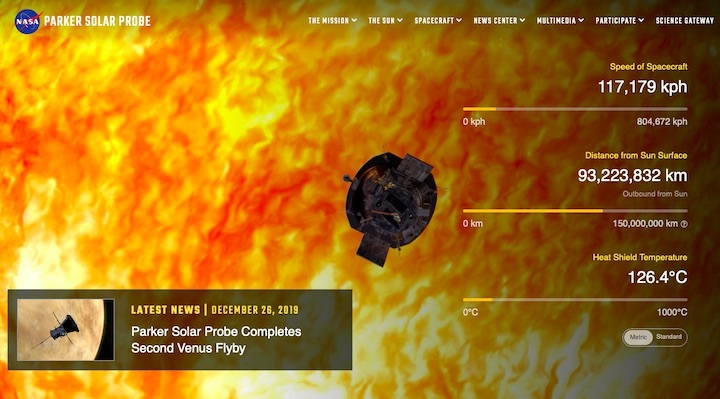
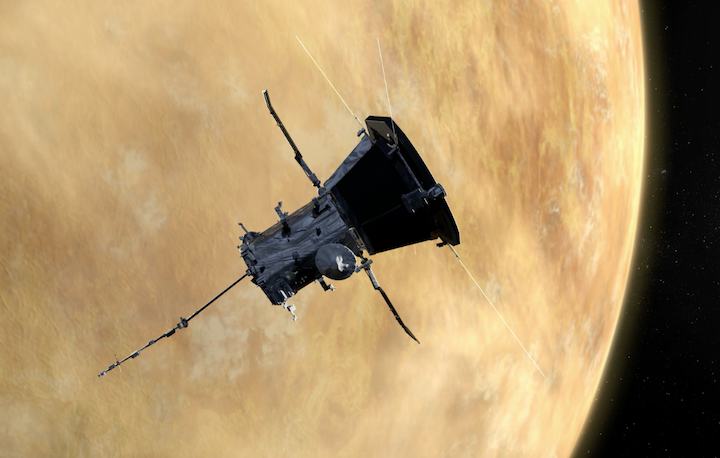
On Dec. 26, Parker Solar Probe successfully completed its second flyby of Venus. The spacecraft used Venus to slow itself down, approaching the planet at a distance of about 1,870 miles from Venus's surface during the second gravity assist of the mission. This gravity assist maneuver adjusted Parker Solar Probe's trajectory to set it up for its fourth orbit around the Sun, or perihelion, which will occur on January 29, 2020. The flight operations team will use the data collected during the recent flyby to make adjustments for the remaining five Venus gravity assists which will occur over the course of the seven-year mission.
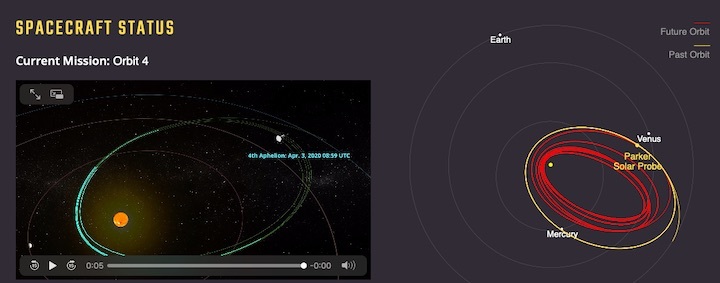
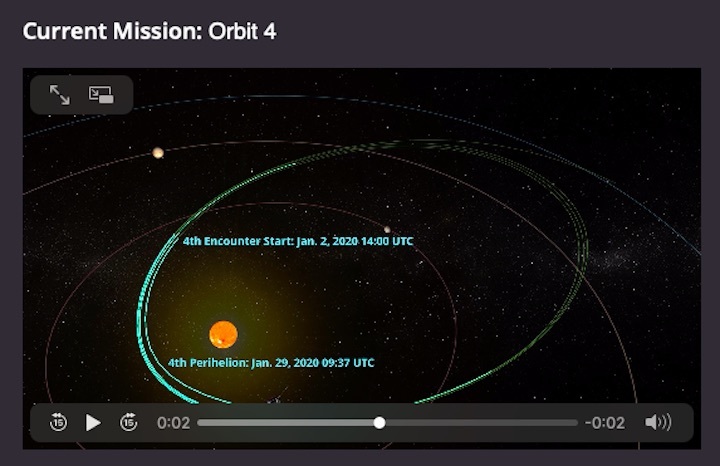

Quelle: NASA
----
Update: 1.05.2020
.
New Insight Into Parker Solar Probe's Early Observations
New analysis published today in the Astrophysical Journal Letters provides a possible explanation for the origin of switchbacks — sudden reversals in the magnetic field of the solar wind — first observed by Parker Solar Probe during its November 2018 solar flyby. A new paper by scientists Justin Kasper and Lennard Fisk of the University of Michigan suggests the origin of switchbacks are related to the way the Sun maintains and moves magnetic field lines that stretch out into the solar system, tied to a theory first proposed more than two decades ago.
The Sun's complex magnetic field is mostly made up of closed loops of magnetic field with both ends anchored in the Sun. The Sun's less-common open field lines migrate between the Sun's north and south poles over the course of the approximately 11-year solar cycle, during which the overall magnetic field reverses in polarity. A theory first published by Fisk and colleagues more than two decades ago explains the process behind this field line migration, and its predictions line up with the switchbacks observed by Parker Solar Probe.
The switchbacks —essentially S-shaped kinks in the magnetic field lines streaming from the Sun — seem to arise from a reconfiguration of open and looped magnetic field lines already in the Sun's atmosphere. When an open magnetic field line encounters a closed magnetic loop they can undergo a process called interchange reconnection. This allows the open magnetic field line to snap into the loop, and allows one side of the formerly closed magnetic loop to connect to solar magnetic field extending outwards into the solar system. This process would create an outward-flowing S-shaped kink in the newly formed open magnetic field line — a shape that tracks with the switchbacks measured by Parker Solar Probe.
This interchange reconnection also drags the open magnetic field line across the solar surface, meaning that the Sun's magnetic field can move east to west faster than solar rotation alone explains. This aligns with observations made during Parker Solar Probe's first solar encounters: the larger than expected “sideways” motion of solar wind near the Sun. This, the authors suggest, is the expression of the plasma’s and magnetic field’s flow pattern deeper in the solar corona.
This theory, first proposed in 1996 based on data from the ESA/NASA Ulysses mission, could unify these two aspects Parker Solar Probe's early observations. The mission's future solar encounters, progressively closer to the Sun, will help scientists further investigate the switchbacks' origins and test the predictions of this theory.
Quelle: NASA
----
Update: 4.05.2020
.
Switchbacks and spikes: Parker Solar Probe data consistent with 20-year-old theory
Magnetic flux findings suggest "profound consequences for basic solar processes."|
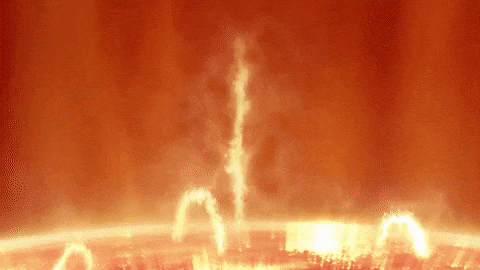
Animation showing a magnetic field line undergoing interchange reconnection then launching a magnetic field switchback into the corona. Animation by NASA and Levi Hutmacher/University of Michigan Engineering
Continued analysis of Parker Solar Probe data is starting to create a clearer picture of the sun’s magnetic activity, which may bolster our ability to predict dangerous solar events.
And the more information that comes in, the more it all fits with theories posited at the turn of the millennium by researchers at the University of Michigan. Justin Kasper, professor of climate and space sciences and engineering at U-M, said those current and former U-M researchers, led by Lennard Fisk, the Thomas M. Donahue Distinguished University Professor of Space Science, pieced together an intricate picture of the sun’s workings long before Parker launched in August 2018.
“This isn’t like having the data and coming up with a theory that happens to line up with it,” said Kasper, who serves as principal investigator for Parker’s Solar Wind Electrons Alphas and Protons (SWEAP) instrument suite. “This is possibly observational closure emerging on a theory that was put out two decades ago.”
The new data is summarized and compared with the previous work in Astrophysical Journal Letters.
Sensors aboard the spacecraft have produced data suggesting:
- The sun’s atmosphere, composed of plasma and magnetic fields, moves in a general global circulation pattern. Parker Solar Probe can observe a small section at any given time.
- Close to the sun, solar wind—the outward stream of charged particles from the surface—is embedded with abrupt changes in magnetic field direction, called switchbacks, along which the solar wind flows at an accelerated speed.
- The global coronal magnetic field slides over the surface of the sun via a process called interchange reconnection—when closed loops of magnetic field sprouting from the sun’s surface explosively realign with open magnetic field lines that extend out into the solar system.
Each of these items reveals fundamental processes occurring at the sun and this understanding has practical applications here on Earth.
“What this gives us is insight into how the sun produces slow and fast solar winds,” said Kasper. “Defining that mechanism is key to predicting when a transition from slow to fast solar wind is going to strike Earth and create a geomagnetic storm.”
Those conclusions agree with predictions put forth in 1999 and 2001 research papers from Fisk and U-M colleagues. One of those, Thomas Zurbuchen, is currently associate director of NASA’s Science Mission Directorate.
“It’s amazing to see Parker Solar Probe provide a missing puzzle piece to support and expand ideas we first thought about with spacecraft data from almost 25 years ago,” said Zurbuchen. “As Parker Solar Probe flies closer to the sun, I can’t wait to see what answers—and questions—we’ll learn next.”

A long time coming
“Badly.”
That’s how Fisk, co-author of the new APJ Letters paper, remembers his earlier work being accepted by solar physicists. It offered possible explanations for how several different solar phenomena interact, but the data to verify such things was limited by technology. Effects of the near-sun phenomena were only observed in the more distant heliosphere. The heliosphere is the region of space, including our solar system, that the solar wind influences.
In those earlier publications, Fisk theorized that, in different areas of the corona, so-called open magnetic lines that stretch from the surface of the sun out into space should circulatein a closed pattern, with motions both in the direction of and opposite to the sun’s rotation. And he also posited that the individual interchange reconnection jumps would combine to permit overall motions of the corona over the surface of the sun.
Fisk found his first clues about the strange magnetic activity in the sun’s heliosphere after combing through data collected during the ESA/NASA Ulysses mission. Launched in 1990, Ulysses was the first spacecraft to pass over the sun’s poles. There, the spacecraft recorded particle radiation that originated at lower solar latitudes—a finding that suggested the magnetic field observed by Ulysses had to be in motion in the solar corona.
The team that conducted this research included Zurbuchen and Nathan Schwadron, now a professor of physics and astronomy at the University of New Hampshire.
Since publication of those earlier papers, Fisk has moved on to other research projects. But his office neighbor just happened to be Kasper. And when Parker Solar Probe’s first data came rolling in last year, Fisk could see how it all fit together.
“Once you get confirmation of this basic process, all of a sudden, there are all of these implications for how the sun works, how its magnetic field works and how the solar wind is accelerated,” Fisk said. “It gives you the opportunity to solve many other solar and stellar physics problems because now you have the basic mechanisms.”
As Parker Solar Probe continues to move closer to the sun, the mission will provide ample opportunity to test and validate predictions by the theory.
Parker Solar Probe is part of the NASA Heliophysics Living With a Star program, created to explore aspects of the sun-Earth system that directly affect life and society. The program is managed by the agency’s Goddard Space Flight Center in Greenbelt, Maryland, for NASA’s Science Mission Directorate in Washington. Johns Hopkins APL designed, built and operates the spacecraft.
The paper is titled “Global Circulation of the Open Magnetic Flux of the Sun.”
Quelle: University of Michigan

